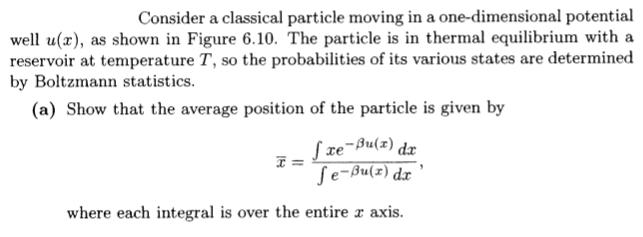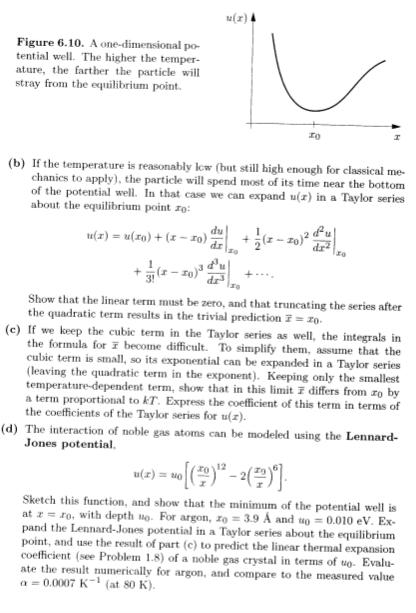Answered step by step
Verified Expert Solution
Question
1 Approved Answer
Consider a classical particle moving in a one-dimensional potential well u(x), as shown in Figure 6.10. The particle is in thermal equilibrium with a


Consider a classical particle moving in a one-dimensional potential well u(x), as shown in Figure 6.10. The particle is in thermal equilibrium with a reservoir at temperature T, so the probabilities of its various states are determined by Boltzmann statistics. (a) Show that the average position of the particle is given by Sxe-Bu(z) dz Se-Bu(z) dr where each integral is over the entire r axis. Figure 6.10. A one-dimensional po- tential well. The higher the temper- ature, the farther the particle will stray from the equilibrium point. (b) If the temperature is reasonably Icw (but still high enough for classical me- chanics to apply), the particle will spend most of its time near the bottom of the potential well. In that case we can expand u(z) in a Taylor series about the equilibrium point zo: u(z) = u(ro) + (x- ro) dr Show that the linear term must be zero, and that truncating the series after the quadratic term results in the trivial prediction 7= ro- (c) If we keep the cubic term in the Taylor series as well, the integrals in the formula for become difficult. To simplify them, assume that the cubie term is small, so its exponential can be expanded in a Taylor series (leaving the quadratic term in the exponent). Keeping only the smallest temperature-dependent term, show that in this limit 7 differs from zo by a term proportional to kT. Express the coefficient of this term in terms of the coefficients of the Taylor series for u(z). (d) The interaction of noble gas atoms can be modeled using the Lennard- Jones potential. Sketch this function, and show that the minimum of the potential well is at r= ro, with depth to. For argon, zo = 3.9 and tuo = 0.010 ev. Ex- pand the Lennard-Jones potential in a Taylor series about the equilibrium point, and use the result of part (c) to predict the linear thermal expansion coefficient (see Problem 1.8) of a noble gas crystal in terms of ug. Evalu- ate the result numerically for argon, and compare to the measured value a= 0.0007 K- (at 80 K).
Step by Step Solution
★★★★★
3.37 Rating (147 Votes )
There are 3 Steps involved in it
Step: 1
answers Solution A model of thermal expansion a Let t...
Get Instant Access to Expert-Tailored Solutions
See step-by-step solutions with expert insights and AI powered tools for academic success
Step: 2

Step: 3

Ace Your Homework with AI
Get the answers you need in no time with our AI-driven, step-by-step assistance
Get Started


